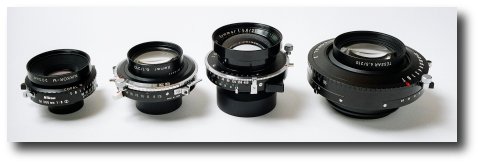
The contestants, from left to right:
Nikon 200mm M f/8
Schneider 210mm Xenar f/6.1
Schneider 210mm Symmar Convertible f/5.6
Docter Optic 210mm Tessar f/4.5
Rodenstock Geronar f/6.8 not shown
Docter Optic 240mm Germinar W f/9 not shown
| Home |
|
Last updated: 16 March, 2006 |

There seems to be a tension between how artists and engineers perceive the world around them. Where arists see mystery and respond with emotion, engineers tend to ask "why?" and then set out to find answers. In my early 20's I worked as a photographer (motorcycle magazine layout work) and B&W print technician in Hollywood. In my mid 20's I returned to the university to work on an engineering degree and was quickly picked up by aerospace. I feel that I can see and understand the tension between artists and engineers fairly well. I live in both "camps", as it were. When it comes to understanding, I try to apply my engineering mind. When it comes to photography, I try to apply my artists mind. With luck, this test applies an engineering mind to what a photographic artist sees. If this article spurs your interest in photography, you may want to check out the photography school at the Academy of Art University or another college."
Kerry Thalmann and I are both engineers with a great deal of curiosity about the world around us. We have submitted many cameras and lenses that pass through our hands to a USAF resolution test chart. The chart was purchased from Edmond Scientific years ago. Resolution testing is not a complete set of tests that can describe optical performance. Things such as contrast, color rendition, and precise abberation measurements are very difficult if not outright impossible to perform using this test method. However, resolution testing can be useful for performing "real world" comparisons between lenses and to begin to learn how resolution influences optical performance.
Resolutiong test results can be quantitative. Relating such results to the "real world" may be somewhat more difficult to understand or realize. This test is an attempt to observe a few "real world" characteristics. In that spirit, here is a test of a few lenses commonly used in 4x5 large format photography. I like the 210mm focal length for many kinds of 4x5 photography, so I thought I would concentrate this test on lenses with focal lengths around this mark. I intend on looking at several dimensions of lens performance and scene rendition.
The goals of this big test matchup include
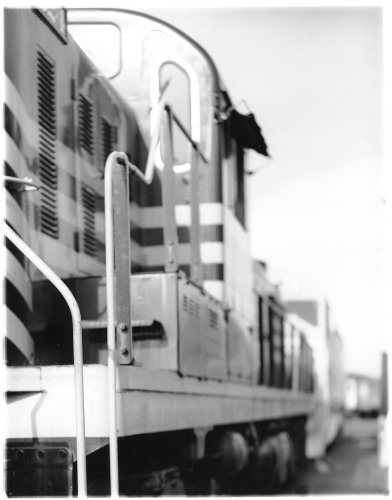
|
|
Docter Optic Tessar f/4.5 - 1/125 sec, f/4.5 |
I have been making black and white photographs for well over 40 years. I have used many film types, many different formats, and many lenses commonly available during this time. One outcome is that I have formed certain ideas and opinions about photography, lenses, cameras, film, processing, and printing. Like many people I tend to hold on to my assumptions with a very firm grip.
For years I have heard that lenses made for consumer grade professional large format photography are optimized for work around f/22. By contrast, lenses made for smaller formats are able to provide sharper images at wider apertures. The common rule being, ...take the lens' largest aperture setting, stop down two stops, and that will be your sharpest aperture... I have tested medium format lenses and camera systems where on-film resolution is outstanding throughout a wide of apertures, not just two stops down from maximum aperture. When I shoot 4x5 or larger, on the other hand, I tend to set the lens aperture to between f/16 and f/32. Force of habit drives this behaviour. Perhaps I should be asking; can I get a very sharp image when using wider apertures in large format work?
I have read comments by a few people in the community of on-line photographers who say that there is a visible difference in how a scene is rendered between various lenses of differing designs. The comment is that different lens formulas will render an image differently. Perhaps this comment comes from reading MTF charts or marketing literature? In any event, it just so happened that I had several lenses in several different design configurations to see if lens design does influence an image.
It is widely assumed that multi-coatings are better than single coatings. Single coatings reportedly transmit 90% of the light they receive. Multi-coatings reportedly transmit 99% of the light they receive. In the real world, would it make much difference which coatings a lens had? I intended to find out.
A few photographers claim that optical design plays an important role in how the out of focus areas of a scene are rendered. Their claim is that design influences out of focus areas in terms of texture and "smoothness" (for the lack of a better term). Some have further claimed that the shape of the aperture (ie: the number of aperture blades) has less influence on out of focus rendition. This has been tied to comments that lens manufacturers can control out of focus feature rendition in pleasing or unpleasing ways through careful optical design choices. There are many examples of what people think they see posted on the 'net. But these are usually for 35mm lenses and very few refer directly to how large format lenses perform in out of focus areas.
I want to understand this better. It would be easy enough to see how a scene could be rendered wide open (if the lens is sharp enough to give a strong in-focus/out-of-focus comparison at wide apertures, that is). I could then compare how various lens designs performed at a common aperture. It would also be interesting to see what effect the shape of an aperture has on out of focus areas.
I have several aperture shapes to choose from. Copal shutters tend to have fewer aperture blades and a sharper transition between blades than, say, a multi-blade Compur or Prontor shutter. Many of my Copal shutter apertures form a "lazy" pentagon as they stop down. Some of the German shutters I have come with enough blades in the aperture that the transition between blades results in a nearly perfectly round aperture shape.
| Make | Model |
Length (mm's) |
Max Aperture |
Shutter |
Weight (grams) |
Image Circle (f/22) |
Filter size |
Configuration (elements - groups) |
| Nikon | M-series | 200 | f/8 | #0 Copal | 180 | 210 | 52 | 4 - 3 |
| Rodenstock | E-series | 210 | f/6.8 | #1 Copal | 295 | 242 | 49 | 3 - 3 |
| Schneider | Symmar Convertable | 210 | f/5.6 | #1 Copal | 525 | 297 | 67 | 6 - 4 |
| Schneider | Xenar | 210 | f/6.1 | #1 Copal | 375 | 255 | 49 | 4 - 3 |
| Docter Optic | Tessar | 210 | f/4.5 | #3 Copal | 565 | 255 | 58 | 4 - 3 |
| Docter Optic | Germinar W | 240 | f/9 | #1 Copal | 280 | 336 | 49 | 6 - 4 |
Nikon 200mm M f/8 -
I had forgotten about Larry's test until I began to gather the lenses for this test. I was hoping to find that at least one of my assumptions was wrong. I was hoping to find that large format lenses were capable of performing as well at wide apertures as their medium format counterparts.
For this test, the 200mm Nikkor M f/8 would act as the modern multi-coated APO wonder optic. I didn't have access to a Schneider APO Symmar or Rodenstock APO Sironar. So this small Nikon lens would carry the flag for what passes for modern APO lenses.
Rodenstock 210mm Geronar f/6.8 -
I was intrigued by the idea that a simple triple design could be updated using modern design methods, new shutters, and newer optical glasses. Some of the finest images St. Ansel took were ones using a simple triplet. With years could come improvements that could lead even skeptics to see what was possible with just a few pieces of glass.
I hoped that it would test sharp enough to allow me to recommend it to new 4x5 photographers who wanted light weight affordable multi-coated entry level optics.
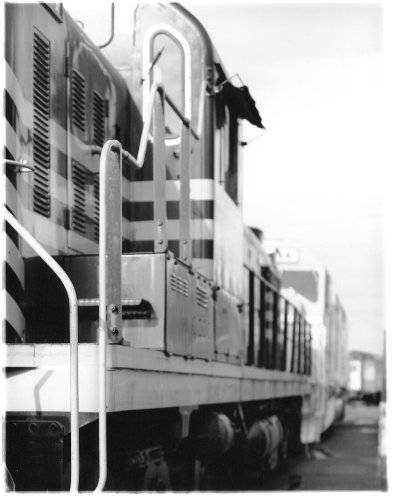
|
|
Docter Optic Germinar W f/9 - 1/60 sec, f/9 |
Schneider 210mm Symmar Convertable f/5.6 -
This plasmat was the first modern generation of plasmats to be designed and manufactured by Schneider. These usually come with two age related challenges. First, Schneider must have left just a little machining lube on the threads when they constructed these. I can't tell you how many of these I have seen that are "cloudy" between the elements. The solution is fairly quick and very simple; disassemble the element sets (but not the cemented pairs) and clean between the lens groups. I needed to do this to my lens and in five minutes I had a clean clear optic. Second, many of these suffer from "Schnieder-itis". This is a condition where the paint around the edges of the cemented element pair "bubbles" away from the glass. It leaves the appearance (to the untrained eye) that perhaps the elements are separating. Such is not the case in many instances. I just "live with it". In practice, a little "Schneider-itis" seldom hurts an image.
The 210mm f/5.6 Schneider Convertible is intended as the standard bearer for old opctics in this test. Professional photographers often over look these lenses as being outdated and lacking of the kind of performance that newer plasmat implementations are reputed to have. My question here was to see if this kind of lens could act as a low cost adequate performance lens, with perhaps some endearing optical qualities that might make them useful for something like portraiture.
Schneider 210mm Xenar f/6.1 -
The role of this lens in my test would be to hopefully show how the traditional tessar design Xenar could compare against the more modern designs. If lens pundits were to be believed, this is just the kind of lens that deserves it's low price.
Docter Optic 210mm Tessar f/4.5 -
Docter Optic was a short lived company. The owner must have been something of an optics nut. He kept some of the original lens designs in production (this is one of them), while at the same time developing new lenses (one of which is also tested here). I'm not sure how many of these big aperture Tessars escaped the factory to successfully live in the wilds. I feel fortunate to own one because it's a real kick in the pants to use. I am able to quickly focus this lens, even in the darkest situations.
The role of the 210mm Docter Optic Tessar f/4.5 lens in this test was to set the baseline for performance. If lens pundits are to be believed, this lens would offer poor performance compared with the more modern plasmats.
Docter Optic 240mm Germinar W f/9 -
I purchased this lens in a barrel and then remounted it in a round aperture Prontor shutter. It's small and light for it's focal length. It could be a nice optic for carrying on travel as part of a 4x5 90mm, 150mm,, 240mm kit. Or it could be a very nice optic for use as a wide angle lens on 8x10.
The role of the 240mm Docter Optic Germinar W f/9 lens in this test was to see what could have been. If Docter Optic could have survived, I wonder how photographers would have responded to the availability of a small, light weight, multi-coated 80 degree Schneider GClaron look-alike.
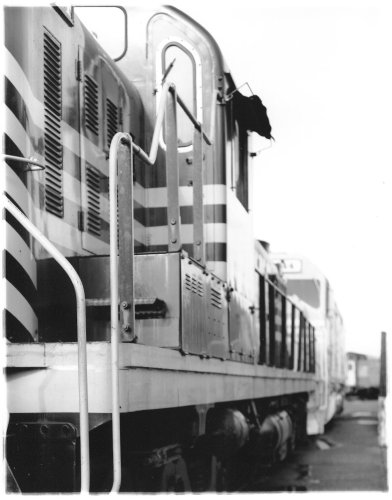
|
|
Rodenstock 210 Geronar f/6.8 1/60th sec, f/11 |
I like trains. So I headed down to my local roundhouse of fun large toys. It was a stormy day and the light was variable (as were the winds). I set up a scene that I felt might work well for the kind of test I was about to perform. I needed something that was, in the same frame, sharp in some areas, out of focus in others, and framed with enough rise and shift to be able to observe image rendition towards the edges of the fields of view of each lens.
As I left the house, I gathered up six lenses, my Arca Swiss 4x5 view camera, a stack of film holders loaded with Kodak TMax100 film, a Pentax 1 degree spot meter, a Bogen 3033 tripod, shutter release cables, a bunch of other required items, and headed off to the Brooklyn Roundhouse adult male's playpen.The Brooklyn Roundhouse plays home to three large steam locomotives, and an ever growing collection of diesel electric engines. Doyle McCormick is well known in these parts for gathering up old and discarded engines, rebuilding them, and pressing them back into limited service. Many of his toys are found resting around the outside of the roundhouse. Included is his "Nickel Plate" locomotive. It still runs strong after all these years.
I chose to work with the front of the "Nickel Plate" engine. The engine stood in the yard with a second old diesel electric locomotive hooked up behind it. These two engines would form the scene for my tests.
| Make | Model |
Length (mm's) |
Coatings |
Aperture blades |
Age |
Market Value |
Notes |
| Nikon | M-series | 200 | Multi-coated | 6 blades | 1990's | $425 used | This is the smallest, lightest weight, shortest focal length lens in the test. Has been a personal favorite for carrying when traveling overseas. |
| Rodenstock | E-series | 210 | Multi-coated | 7 blades | 1990's | $200 used | This is a small simple optical design three element, light weight lens. Largely overlooked for serious work due to price and simplicity. |
| Schneider | Symmar Convertible | 210 | Single coated | 7 blades | v.early 1970's | $175 used | This is a heavy lens due to it's brass lens barrels. Widely availble and cheap. The design was Schneider's first modern plasmat. Largely overlooked due to age. |
| Schneider | Xenar | 210 | Single coated | 7 blades | 1978 | $165 used | This a fairly light optic. It is surprisingly crisp and easy to focus on the ground glass. Not as much coverage as a plasmat, but niether is it as large nor as heavy either. A potential jewel of a lens. |
| Docter Optic | Tessar | 210 | Single coated | 7 blades | 1991-1994 | $300 new | A true rare optic with a very large aperture and the largest shutter of any lens in this test. By far the brightest lens on the ground glass, but not as "snappy" or contrasty on the groundglass as the f/6.1 Xenar. |
| Docter Optic | Germinar W | 240 | Multi-coated | 10 blades | 1992-1994 | $250 new in barrel, $50 used shutter | A truely rare optic. Perhaps less than 90 in existence. This is what the Schneider GClaron could have been. This is small, light, provides massive coverage, and comes multi-coated. I mounted this in a round aperture Prontor shutter. |
| Schnieder | Symmar Convertible | 210 | Single coated | 10 blades | v.early 1970's | $175 used | I remounted this heavy plasmat into the round aperture Prontor to see what, if any, difference the aperture shape had on out of focus areas. I shot the lens/shutter combination at f/11 for this test. |
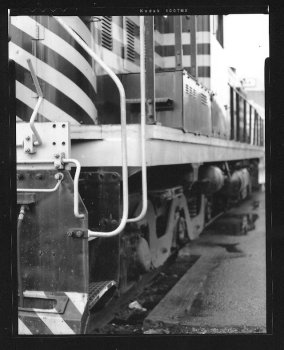
|
|
Nikon 200 M f/8 1/125th sec, f/8 Test scene setup Defining the center of the field |
I worked as quickly as I could. The light changed as the sun passed behind high thin clouds by about 1 stop from full sun to filtered light. I verified the scene changes by re-metering.
The test setup was simple and straight forward. The ultra strong Bogen 3033 tripod was erected, the Arca Swiss was mounted up, and the first lens was selected. Focusing the Arca was a breeze, due in large part to it's standard very bright focusing screen.
Each of my film holder were labled on each side with a "notes" sticker. Each lens would be subjected to a two exposure test. The first exposure would be taken at the aperture set to wide open. The second exposure would be set to an aperture of f/11. To help me keep things straight at the time of exposure, and later for development, each sticker contained the lens model and the aperture I was to shoot at. Each film holder had an indication of wide open on one side, and f/11 marked as the aperture setting on the opposite side.
I first selected the Nikkor 200M f/8. I tooks a "straight on" shot to set the test paramters by illustrating a very plain scene. Then I offset the rear standard to set the "center" of the "straight on" image to the left one and a half inches. I raised the front standard two inches to place the "center" of the "straight on" image in the lower left corner of the ground glass. The 200M Nikkor was then reshot wide open, and then at f/11. Using this offset scene, I then shot the 210Xenar, followed by the 210Symmar, 210Geronar, 210Tessar, 240Germinar W, and lastly the 210Symmar remounted in the round aperture Prontor shutter. For the last lens test setup, I assumed the the wide open data from the first 210Symmar exposure was sufficient. So I only shot the 210Symmar at f/11 in the round aperture Prontor shutter.
I need to say something about the Arca Swiss Discovery 4x5 view camera that I used for this test: I am not worthy! A friend suggested that it is the cameras the gods themselves use. It is gorgeous. It is quick and simple to use. It is precise. It is stable. It is a very fun camera to use. For me this is really saying something. After years of fiddling with Sinar, Linhof, Tachihara, Graflex, Calumet, and fondling Ebony cameras, nothing in my estimation comes close to the build quality and ease of use of Arca Swiss F-line cameras.
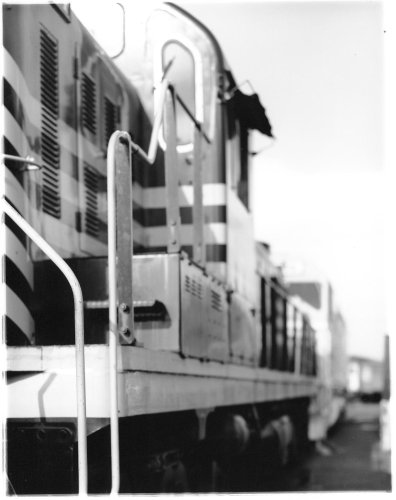
|
|
Schneider 210 Symmar Convertible f/5.6 1/125 sec, f/5.6 |
I used my standard materials and processes for this test. The film is my favorite in 4x5 B&W. I use used this combination of chemistry and film processing for years and I feel comfortable with it. This gives me very consistant results from batch to batch, from year to year.
Similarly, I used my standard printing processes and materials. Though with the unfortunate exit of Kodak from the paper business, I have moved to Ilford materials.
As soon as the negs were dry I couldn't contain myself. I had to take a quick peek at them to see if I could make anything out from the test. Using a 10x loupe, I inspected the negatives in both the sharp and out of focus areas. Here are my initial observations:
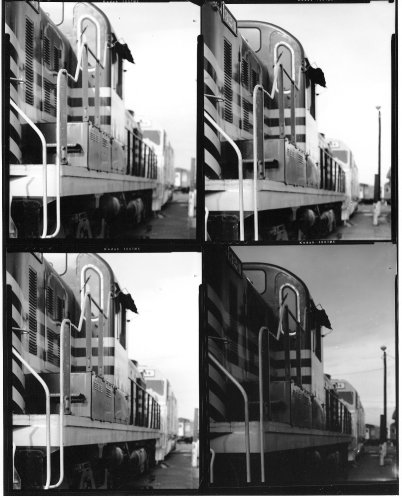 |
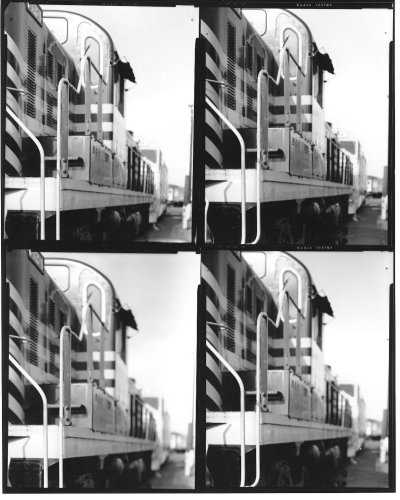 |
|
Clockwise from upper left: Docter Optic 240 Germinar W at f/9 Nikkor 200 M at f/8 Nikkor 200 M at f/11 Docter Optic 240 Geraminar W at f/11 |
Clockwise from upper left: Docter Optic 210 Tessar at f/11 Schneider 210 Symmar Convertible at f/11 Schneider 210 Symmar Convertible at f/5.6 Docter Optic 210 Tessar at f/4.5 |
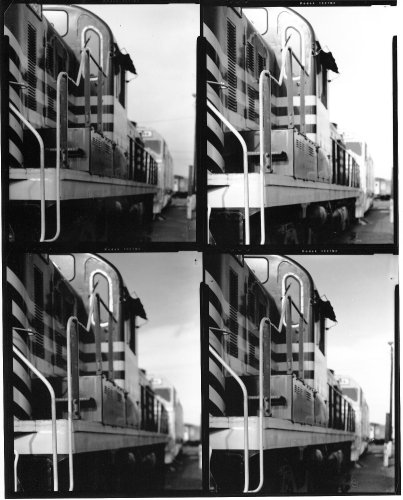 |
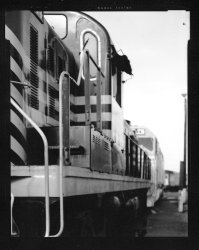 |
|
Clockwise from upper left: Schneider 210 Symmar in Prontor at f/11 Schneider 210 Xenar at f/11 Rodenstock 210 Geronar at f/6.8 Schneider Xenar 210 at f/6.1 |
Rodenstock Geronar at f/11 |
I noticed that I under-exposed the Nikkor 200 M f/11 image. I don't know by how much I underexposed, but it feels like nearly two stops. I must have set the shutter speed the wrong direction when I changed the aperture.
All other images are correctly exposed. The contact sheets showed bright sharp images. Under my 2.5x reading glasses I can't see any resolution differences. Under the 10x loupe, reading the contact images is really no better than inspecting the negatives directly. Yet, inspecting the contact prints with the 10x loupe showed some f/11 images to contain what can only be described as "harsh" out of focus areas. Some portions of the out of focus areas showed sharp lines where my mind was thinking soft smudges.
In summary, a review of the contact sheets clearly revealed which images were shot wide open and which were shot at f/11. The images that were shot wide open all had a nice creamy out of focus area rendition. The texture and shape of the out of focus area was consistantly beautiful. Some f/11 images had harsh out of focus areas. This will be explored in more detail in a moment.
| Make | Wide Open | f/11 |
|
Nikkor 200 M f/8 |
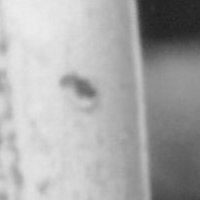
|
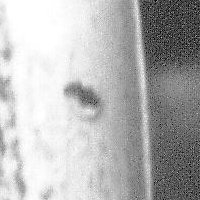
|
|
Docter Optic 210 Tessar f/4.5 |
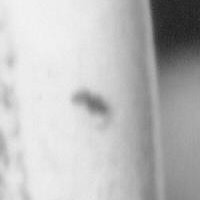
|
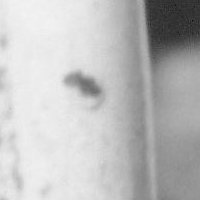
|
|
Redonstock Geronar f/6.8 |
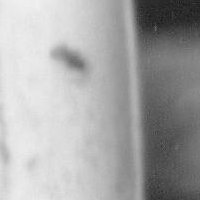
|
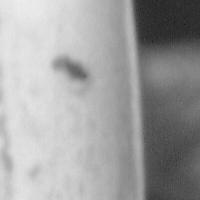
|
|
Schneider 210 Symmar Convertible f/5.6 Copal #1 |
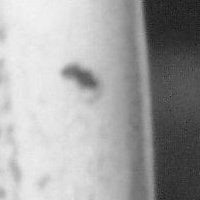
|
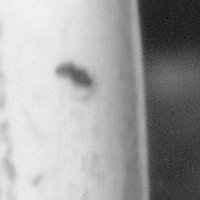
|
|
Schneider 210 Symmar Convertible f/5.6 Prontor #1 |

|
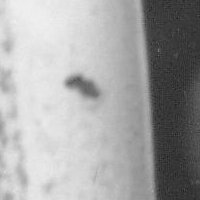
|
|
Schneider Xenar f/6.1 |
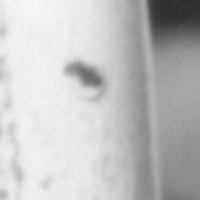
|
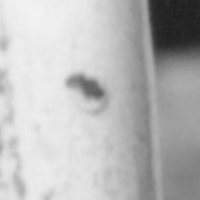
|
|
Docter Optic Germinar W f/9 |
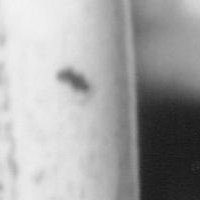
|
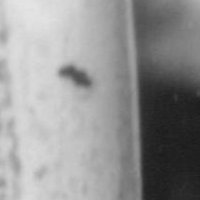
|
After making the proof sheets I worked to print the stack of thirteen images that make up this test. All prints were made to 7.5 x 9.5 inches. All images for the table above were scanned at 1200dpi, with 200x200pixel segments from each scan extracted to illustrate the results. The 500 pixel high images seen sprinkled throughout this document were scanned at 175dpi and resized to what is seen here.
I began by inspecting the original prints without the aid of a magnification device. In general it is fairly easy to tell which images were taken wide open. The prints show a nice "creamy" texture in the out of focus areas and crisp details in the in-focus subject matter. One pair of prints were slightly softer looking and presented slightly less contrast than the other eleven images. The softer looking images were made using the Rodenstock 210 Geronar. For the remaining eleven images, resolution and contrast were equal. In the out of focus regions, there was clear indication of differences between the prints. These differences will be explored in detail shortly.
I then inspected the original prints with a pair of 2.5x reading glasses. I use these glasses to help view the cameras ground glass when taking photos. My eyes no longer focus to six inches, and this is the distnace I like to view the ground glass from. Inspecting the prints with these glasses I confirmed that a pair of prints were not quiet as sharp as the other eleven. Again, these softer looking images had been made using the Rodenstock Geronar. The eleven remaining prints all looked nearly equivalent at 2.5x magnification. That is to say, there were no readily identifiable differences in resolution or contrast between them. However, differences in how the out of focus regions were rendered was clearly visible.
I then took a 10x loupe and re-examined the prints. This examination confirmed earlier observations, and added a few new observations that I needed to consider. Under a 10x loupe, I could separate the images into third "grades" of resolution. The softest grade remained the Rodenstock Geronar, as I expected. The next grade of prints were found to be closer to the highest grade than to the soft. In this group fell the Docter Optic Tessar at f/4.5 and the Schneider Symmar Convertible at f/5.6. Into the best resolution group fell the Schneider Xenar at f/6.1, the Nikkor M at f/8, and all the lenses except for the Rodenstock at f/11.
For my last inspection sequence, I raised my enlarger head to 16x20 and used a 40x grain focuser (Omega swivel head long mirror device) to view the infocus areas of each negative. I "graded" the images from softest to sharpest. Softest were the Rodenstock negs, by a large margin. Next softest, but actually quite sharp by comparison to the Rodenstock images were the Docter Optic Tessar at f/4.5 and the Schneider Symmar at f/5.6. The next step up in resolution were the Docter Optic Tessar and the Schneider Symmar at f/11, and the Docter Optic Germinar W at f/9. By a remarkably slim margin, the following lenses were the sharpest of the bunch: Nikkor M and Schneider Xenar both wide open and then at f/11, and the Docter Optic Germinar W at f/11. If I had to choose just one lens as being the sharpest, it would be the Schneider Xenar at both f/6.1 and f/11. But this would be splitting very fine hairs indeed.
I can perceive no influence of aperture shape on image resolution.
| Make | Wide Open | f/11 |
|
Nikkor 200 M f/8 |
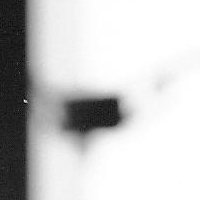
|
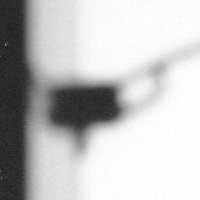
|
|
Docter Optic 210 Tessar f/4.5 |
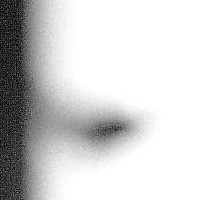
|
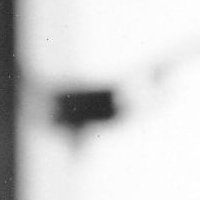
|
|
Redonstock Geronar f/6.8 |
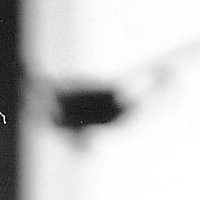
|
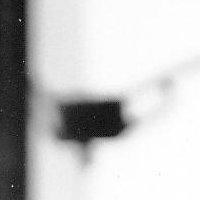
|
|
Schneider 210 Symmar Convertible f/5.6 Copal #1 |
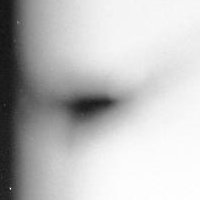
|
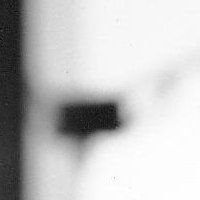
|
|
Schneider 210 Symmar Convertible f/5.6 Prontor #1 |

|
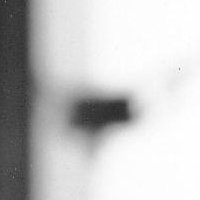
|
|
Schneider Xenar f/6.1 |
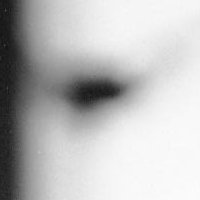
|
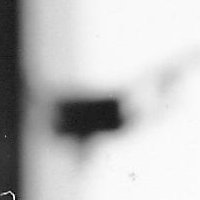
|
|
Docter Optic Germinar W f/9 |
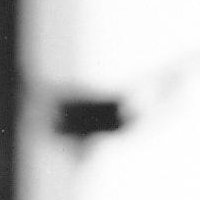
|
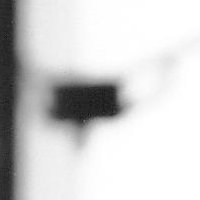
|
The plasmat (6 element, 4 group) design lenses shot wide open rendered the canopy detail without distortion. This included the Schneider Symmar Convertible at f/5.6 and the Docter Optic Germinar W at f/9. I believe the canopy was well within the coverage area of the lens design.
The tessar (4 element, 3 group) design lenses shot wide open presented distortion in two cases, and a nearly (but not quite) neutral image in the third case. The Docter Optic Tessar at f/4.5 and the Schneider Xenar at f/6.1 showed some distortion in the manner of what I believe some people call a tilted iris. The Nikkor M a f/8 was quite nearly neutral in this area. The triple element lens wide open looked very similar to the Docter Optic. However, I can see the Rodenstock presents a slightly different image distortion.
At f/11, all the lenses cleaned up nicely and rendered the canopy in a fairly neutral way. But there were differences. The most "pleasing" were the Docter Optic Tessar, the Docter Optic Germinar W, and the Schneider Symmar Convertible mounted in the Prontor shutter. In truth, the Schneider Xenar image didn't look too bad either.
From this portion of the test I could see where lens design influenced image rendering. I believe that area of coverage plays a significant role in how off-axis areas look and feel. I could also begin to tell the influence of aperture shape on out of focus areas. Differences between the Schneider Symmar in Copal shutter and the same lens mounted in a Prontor shutter became evident. My preferences were for the Prontor shutter rendering.
| Make | Wide Open | f/11 |
|
Nikkor 200 M f/8 |
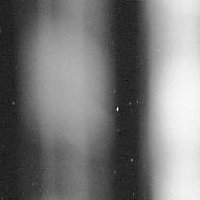
|
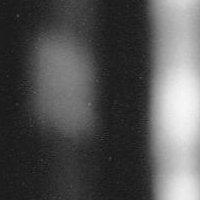
|
|
Docter Optic 210 Tessar f/4.5 |
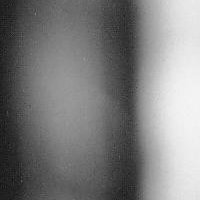
|
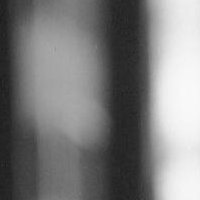
|
|
Rodenstock Geronar f/6.8 |
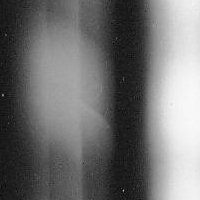
|

|
|
Schneider 210 Symmar Convertible f/5.6 Copal #1 |
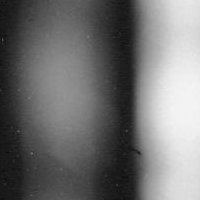
|
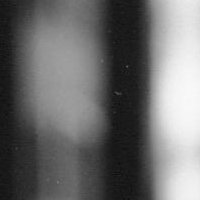
|
|
Schneider 210 Symmar Convertible f/5.6 Prontor #1 |

|
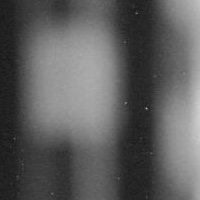
|
|
Schneider Xenar f/6.1 |
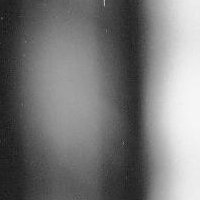
|
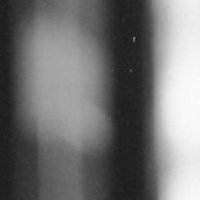
|
|
Docter Optic Germinar W f/9 |
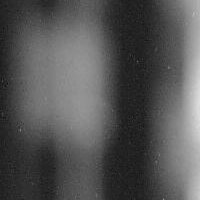
|

|
There was an area of alternating light and dark details long the side of the locomotive that looked pretty interesting. I used this area to assess the differences in image rendition in the out of focus areas between lens design and aperture shape.
Wide open, the least pleasing images were produced by the Nikkor M and Rodenstock Geronar lenses. The Geronar image looks slightly distorted to me. The highlight "drags" in a way that none of the other lenses did. The Nikkor M gave sharp "edges" in the highlights in the transistion from dark to light.
The most pleasing images wide open are the Schneider Symmar, Xenar, and Docter Optic Tessar and Germinar W lenses. These lenses produced a very clean, pleasing transitions from dark to light. I'm left wondering it is how a basic lens design is implemented that determines the rendering of out of focus areas. Afterall, the Schneider Xenar and Docter Optic Tessar did quite well, and the Nikkor M returned sharp edges to it's out of focus details.
At f/11, differences between image rendering came down to a single factor; aperture shape. The Nikkor M, Schneider Xenar, Docter Optic Tessar, Rodenstock Geronar, and Schnieder Convertible in Copal shutter all clearly show the aperture shape in the rendering of the highlights. The Docter Optic Germinar W and Schnieder Symmar Convertible mounted in the round aperture Prontor shutter gave nice clean pleasing transitions from the dark to light areas. The highlights were rendered as pleasing round areas of lightness. This is quickly verified by looking at the negatives under a 10x loupe and at the 8x10inch prints.
I have two USAF resolution test chart results for Nikkor 200mm M f/8 lenses. One of these is my much loved and heavily used optic. The other was borrowed from a friend. I have included these results here so that people can "see" how lines per millimeter compare to a final print result.
The following is a side by side resolution comparison between the four cameras in this test. Resolution is reported in lines per mm. From left to right, I show the center, middle, and edge resolution readings at the specified apertures. I also include a copy of the 1200dpi scan of the sharp image area of my Nikkor shot at f/11.
|
Nikkor 200mm M serial #200xxx |
Nikkor 200mm M serial #201xxx |
Nikkor 200mm M f/11 sample |
|
f/11 68 76 38
f/16 68 68 34 f/22 60 54 48 |
f/11 60 60 30
f/16 67 60 30 f/22 60 67 54 |

|
From these results I feel that my Nikkor 200 M f/8 is certainly sharp. Prints that I have made from the lens rival the contrast and resoltion of 8x10 contact prints that I have made over the years. Comparing the f/11 images from the lenses in this test shows me what is possible to achieve. Resolution and contrast between the Schneiders and Docter Optic lenses are all very nearly equivalent at that aperture.
Reviewing my original assumptions has helped re-educate me to what is true and can be applied in my day to day image making.
I assumed that large format lenses were optimized for performance around f/16 to f/22. The Schneider Xenar, Docter Optic Germinar W, and Nikon M all proved that assumption wrong. Even the Schneider Symmar Convertible helped show what is possible when a large format lens is shot wide open. Images from all these lenses are very sharp. This finding makes me realize that selective focus large format images in many cases will not be soft. It appears that many large format lenses can be used wide open and retain critical focus, image resolution and contrast.
I assumed that lens design has no influence on a final image. In this test I can see no differences between tessar formula (4 element, 3 group) and plasmat (6 element, 4 group) images. Image softness (a true lack of resolution) is apparent at wide apertures in the simple triple element Rodenstock Geronar images. From looking at images my friend created using this lens, if the Geronar is shot at f/16 or f/22, it becomes as sharp as anything tested here. With the caveat concerning the Rodenstock, I feel my original assumption is correct.
I assumed that a careful photographer would be able to tell the difference between images created using single coated and multi-coated optics. From what I see here, the single coated Schneider Xenar is just as sharp and just as contrasty as my multi-coated Nikkor 200 M. Single coated Schneider Symmar Convertible images are just as sharp and contrasty as multi-coated Docter Optic Germinar W images. In fact, I can tell absolutely no difference between the single and multi-coated lenses in this test. My original assumption is false.
I assumed that within the limits of lens coverage, aperture shape was the only influence on the rendition, texture, and shape of out of focus areas. At the risk of being brash I'll say I was quite right in my assumption. There is plenty of information on-line concerning aperture shape influencing something called "bokeh". Many people relate aperture shape to highlight rendition. What I wasn't prepared for was how aperture shape influences out of focus non-highlight regions.
When I look at old photographs from the 1920's through to around 1950 or thereabouts, it seems to me that large format image out of focus areas have a "creamy" well rounded good to look at feel about them. Some photographers I have spoken with say that this is due to residual uncorrected spherical aberrations. I now think it's something else. It's hard for me to see how an image can be critically sharp in the in focus areas and creamy smooth in the out of focus areas by optical design. There must be something else in play to be able to acheive this effect.
After performing this test, I believe I begin to understand why old photos can have those qualities. Small blade number apertures can produce rapidly changing dark to light transitions that can be perceived as "harshness". On the other hand, old lenses tend to have many many aperture blades that define a nearly round aperture shape. This is the single most important influence on out of focus area rendition. Further, I believe it is possible to duplicate this effect with modern optics by simply mounting them in multi-blade apertured shutters.
For me this is a very significant finding.
The raw scans can be found here. There is a readme file that describes my file naming convention. While not as good as original prints, images found there can give a good idea of the details behind my comments here.
In closing, I am very pleasantly surprised at the resolution and contrast performance of my $165 Schneider Xenar f/6.1 lens. This lens gives incredible performance for the money. I am pleased to confirm my Nikkor 200 M f/8 as a fine performer. When using a Rodenstock Geronar lens, just make sure to stop down to at least f/16. When considering cost performance trades off's between old Schneider Symmar Convertible lenses are the newer APO wonder optic, photographers need not worry about the performance of the older lenses. When debating the benefits of single vs. multi-coatings, well, the results here speak for themselves.
Perhaps the best realization I had in doing this test
is that aperture shape influences more than
just out of focus highlight shape and rendition. It defines
everything about out of focus area rendition, shape, and texture.
Fraction Reducer
Easy to use Fraction Reducer